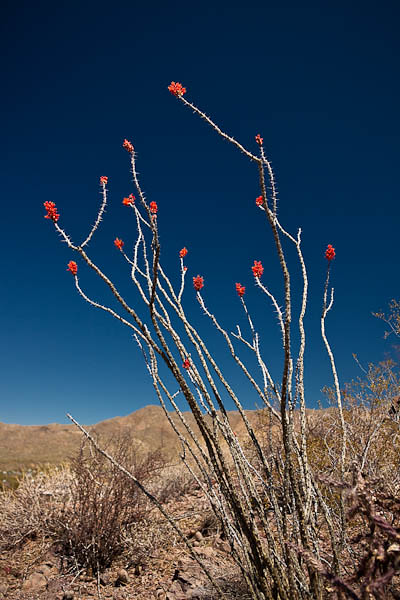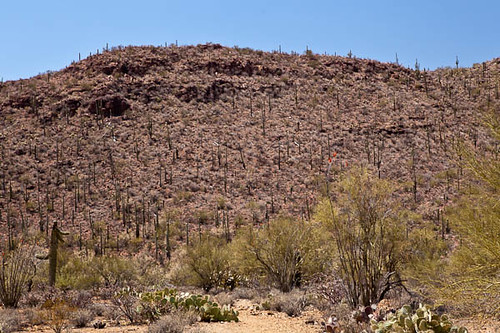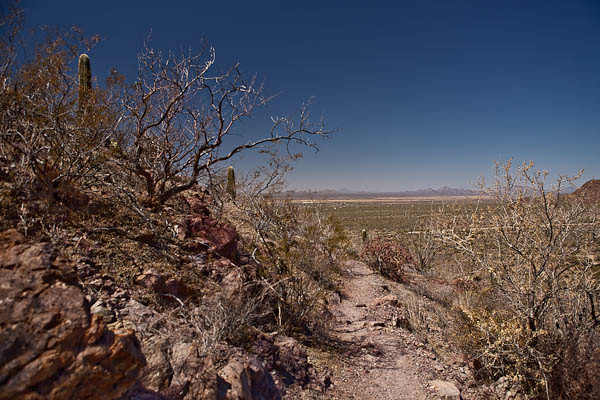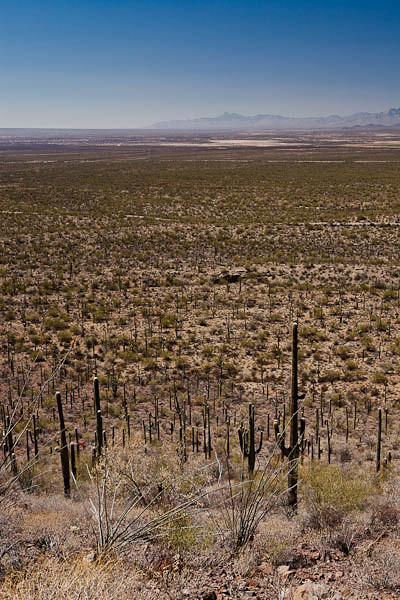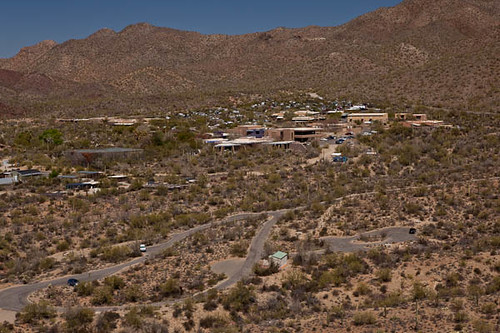There are trails that criss-cross the desert and desert mountains surrounding Tucson. Tucson Mountain Park, which runs along much of the west border of Tucson, is one of the most easily accessible areas for day hiking. Best of all, there are hikes for all levels of difficulty and time required. It is a simple matter to stop at one of the many asphalt pull-offs to take a photograph or two–such as this photo of a blooming ocotillo that was only a few feet from the road–and a ten minute hike to check out the desert landscape and plants. Or, with basic preparation, it is convenient to plan an all day hike through the Tucson Mountains.
One of the first hikes I took in Tucson Mountain Park was a climb up (and down) Brown Mountain. I thought Brown Mountain was aptly named since it is a mountain mostly of brown rock with scattered saguaro and other cacti.
Wrong. Brown Mountain is named for the first administrator of Tucson Mountain Park, a Mr. Cornelius Brown who was instrumental in creating the park in 1929 and was an agricultural agent in the region from 1920 to 1945. (Thank you, Mr. Brown, for without your forward thinking, these mountains would be dotted with all types of structures. Instead, except for a few special use permits, these mountains are quite pristine.)
I went looking for information about this mountain in one of the many reference books about Arizona that I have gradually collected over the past 4 years. I don’t usually laugh when researching “rocks” but I discovered in the book Roadside Geology of Arizona by Halka Chronic that these mountains are made of up so many different kinds of rock–ancient lava flows, volcanic ash, Paleozoic limestone, and more–that geologists call this mixture of rock the Tucson Mountain Chaos.
The trail is a loop trail circling the north and south ridges of Brown Mountain. There is are two trail heads–one at Brown Mountain Picnic Area and the second at Juan Santa Cruz Picnic Area. When starting at Brown Mountain, there are a couple of washes to cross and a rocky trail before reaching the switchbacks that climb the mountain. When starting from Juan Santa Cruz, the trail head is behind the picnic site north of the rest room. Rock steps carved by the CCC in the 1930s lead down to a wash, and then up on the other side where a switchback trail ascends to the ridge.
There isn’t a lot of elevation gain, so even though most references consider this a moderately difficult hike, there are only a few short sections that require much effort. And those sections are worth the effort, for the view, if not breath-taking, is interesting. To the west, the peaks of Baboquivari and Kitt Peak are visible on clear days. And there are saguaro everywhere, a virtual sea of saguaro.
One also gets a birds eye view of many desert attractions in the near by area. The Arizona Sonora Desert Museum just beyond the Juan Santa Cruz Picnic Area. The Desert Museum is the second most visited destination in Arizona, second only to Grand Canyon National Park. I’ve visited several times and it does give an excellent overview of the Sonoran Desert–a combination botanical garden, zoo, arboretum, and learning center. Just down the street is Old Tucson Studios, a tourist site and movie set for many of the classic Old West movies. And Saguaro National Park is adjacent to Tucson Mountain Park, so you can take advantage of National Park programs and ranger led hikes, if you want.
What a great area filled with a variety of features to visit when in Tucson. And with so many different activities to choose from, it never seems too crowded.
———————
Bo Mackison is a photographer and owner of Seeded Earth Studio LLC. She is living in Tucson for two months, exhibiting her photography in art shows, taking photographs, and blogging about photography, art fairs, and living life “solo.” She spends a portion of each day exploring the desert.
